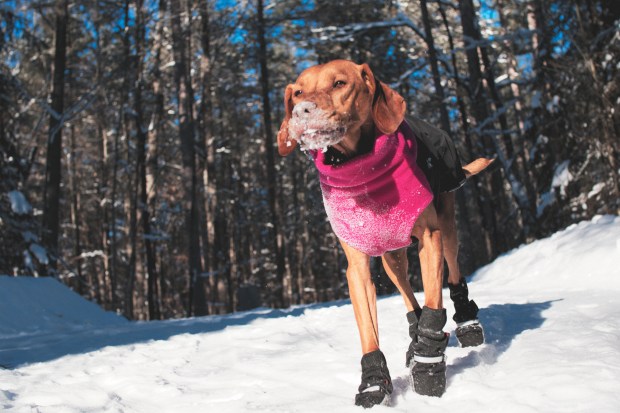When temperatures drop, and snow and ice cover your sidewalks, it’s vital to take extra care to protect your dog’s paws.
Just like we bundle up in warm jackets and boots, dogs can also benefit from extra protection, especially for their paws, which are particularly vulnerable to cuts, scrapes from icy surfaces, burns, and irritations caused by ice and snowmelt.
While some might consider dog boots unnecessary or even frivolous, they can protect your pup’s feet against harsh winter conditions.
“I’ve had decent patient success with dog booties if you can get your dog to wear them,” said Dr. Kramer Gopffarth, lead and founding veterinarian at Livewell Animal Hospital in Denver. “The boots provide a barrier so their feet don’t get too cold.”
Dr. Steve Batch, co-medical director at Mesa Veterinary Hospital in Golden, said each dog is different, and you must respect your dog’s preferences.
“Some dogs will be paralyzed with a single ice ball between the toes without a boot on, while other dogs will hike or hunt all day with reckless abandon, all the while having pad abrasions or worn off pad surfaces and never show any lameness but be unable to walk the next day due to sore feet,” he said.
Dog boot benefits

Dog boots protect against cold, wet, and abrasive winter conditions. Snow and ice can cause discomfort for your dog’s paws, while salt and other de-icing chemicals can irritate.
Boots shield your pup’s paws from these harsh elements, allowing them to enjoy outdoor adventures without discomfort. They help prevent injuries, cushioning their paws and keeping them safe from potential hazards like cuts and abrasions from sharp ice or rugged terrain.
Wearing boots can also improve traction on slippery surfaces, especially for dogs prone to slipping or falling. Many dog boots feature soles that offer enhanced traction, which can help your dog get a better grip and balance on icy sidewalks or snow-covered trails, ensuring more secure footing and reducing the risk of accidents.
When dogs need boots
Veterinarians say there are specific conditions in which dog boots help provide safety and comfort.
Harsh weather: Boots can protect against frostbite and discomfort in frigid weather. Similarly, boots can prevent burns on sensitive paw pads during hot summer days when pavement temperatures soar.
Urban environments: Boots provide a barrier against salt or de-icing chemicals used to treat city sidewalks.
Hiking and rough terrain: Rugged or rocky trails can lead to cuts and abrasions if you take your dog on hikes. Boots can provide essential protection, allowing your dog to explore without injury.
Dangerous plants: Dog boots protect paws from hazardous plants and pests like fleas and ticks. For example, boots prevent foxtail seeds from getting stuck in their fur or paw pads.
Post-surgery or injury recovery: If your dog is recovering from an injury or surgery, boots can protect sensitive areas, keep them clean, and promote healing.
Choose the proper boots for your dog
Selecting the appropriate boots for your dog is essential to ensure both protection and comfort. Making sure the boots fit is crucial, Batch said.
“I have seen major skin issues under some boots due to poorly managed moisture accumulation (failure to let the feet air out and failure to dry the inside of the boots) and incorrect tape application issues where the tape was intended to keep the boots from slipping off and resulted in pressure sores and abrasions,” he said.
Dog owners must check their pup’s feet throughout the day and evaluate any signs of limping or pain.
“You must check the pads for any abrasions, pain, loss of surface integrity, check between the toes for any inflammation, foreign material, swelling, draining tracts, or lacerations, and check where/how the boots are secured (Velcro strap, elastic opening, or taping job) for any skin disruption,” Batch said.
“If in doubt — stop, let them rest, check again, and get veterinary help if you are unsure.”

Here are some tips to make sure your dog’s boots fit:
Measure correctly: Accurate measurements of your dog’s paws are crucial. Have your dog stand on a flat surface. Gently press down on the top of the paw to spread the toes apart. Measure the widest part of the paw (usually where the toes meet the pad). Note the width in inches or centimeters.
Measure the length from the tip of the longest toe to the back of the paw pad. Ensure your dog is standing naturally for an accurate measurement.
Each brand may have different sizes, so use your measurements to refer to the manufacturer’s size chart. Some brands also provide size recommendations based on weight.
Try them on: If possible, have your dog try on the boots to see how they fit. Ensure they are snug but not too tight, and get your dog to walk around to ensure comfort. You should still be able to slide a finger between the boot and your dog’s leg.
Opt for boots with adjustable straps or Velcro closures to ensure a secure fit and make them easier to put on and remove.
Material: Look for boots made from durable yet flexible materials that provide warmth and protection without sacrificing comfort.
Rubber provides water resistance and durability, making it ideal for outdoor activities. It also offers good traction.
Neoprene is flexible, providing a snug fit while still allowing for movement. It’s also water-resistant, helping keep moisture and dirt out.
Breathable mesh is ideal for lightweight boots and allows for ventilation, helping to keep your dog’s paws cool.
Cordura nylon is highly durable and tear-resistant, protecting paws on rough terrain.
Adding fleece or soft materials inside the boots can provide extra comfort and warmth, especially in cold weather.
Traction: Choose boots with non-slip soles designed for different terrains. If your dog is prone to slipping, consider options with enhanced traction for added stability on icy or snowy surfaces.
Help your dog adjust to boots
Teaching your dog to wear boots can take time and patience, but you can help them feel comfortable and secure.
Here are some strategies to ease the transition:
Introduce gradually: Let your dog sniff and explore the boots before putting them on.
Short sessions: Once your dog seems comfortable with the boots, try putting them on for brief periods, starting with a few minutes. Gradually increase the duration.
Positive reinforcement: Use treats, praise, and affection to create a positive association with the boots. Reward your dog for wearing them and for any steps they take.
Practice indoors: Allow your dog to wear the boots indoors on a non-slippery surface before venturing outside where there are more distractions.
Playtime: While wearing the boots, engage your dog in favorite activities like playing fetch, tug-of-war, or exploring the house. Keeping your dog entertained will help it forget about the boots.
Monitor their comfort: Watch how your dog reacts. Look for signs of discomfort, such as excessive shaking, sitting down, or trying to chew off the boots. If your dog seems distressed, reassess the fit or take a break.
Be patient: Every dog is different. Some may adjust quickly, while others may require more time. Stay patient and consistent in your approach, and allow your dog to set the pace for how quickly they adapt to the boots.
Using dog boots
When using dog boots, monitor your dog’s comfort and don’t expect them to be an instant fix for freezing temperatures or lack of conditioning.
“Common sense says to not take your dog on a 5-mile hike on rough terrain when their feet (pads) are only used to carpet and grass (the weekend warrior syndrome),” Batch said.
If your dog refuses to wear boots, consider other options, such as Vaseline or Musher’s wax, to coat its paws and create a barrier against the elements.
And when the temperature drops below freezing, keep your walks short — 10 to 15 minutes.
“Pay attention to your dog and watch for signs they are cold and don’t want to play or walk,” Gopffarth said.
Devon Toczek, vet assistant at Companion Animal Veterinary Hospital in Centennial, also encourages dog owners to wipe their pup’s paws with a damp towel when they return indoors.
“That way, you can remove any salt or chemicals that may have accumulated,” she said. “Otherwise, they will lick their paws to get that off and it causes gastro-intestinal upset.”
This post was originally published on this site be sure to check out more of their content.














































